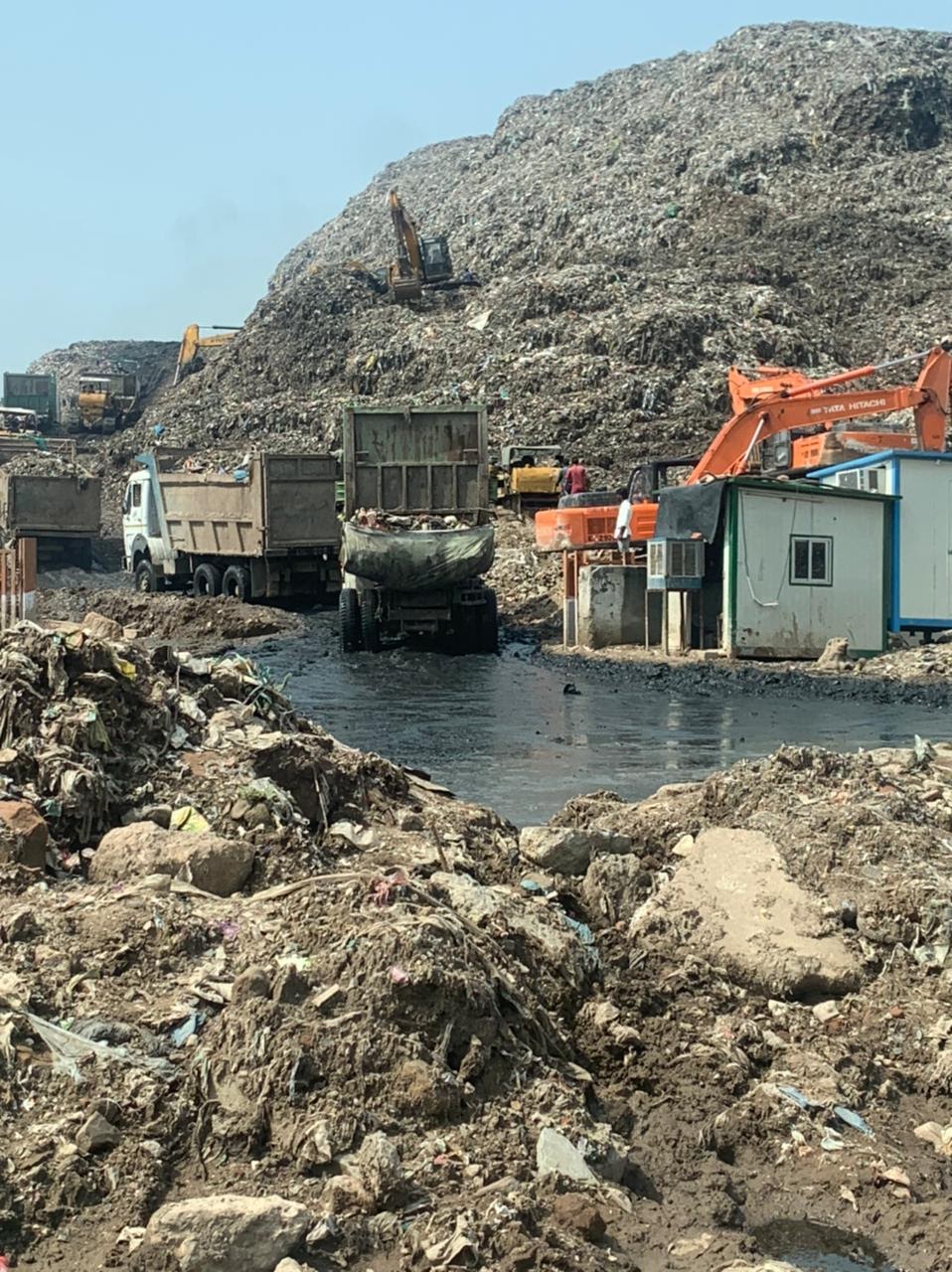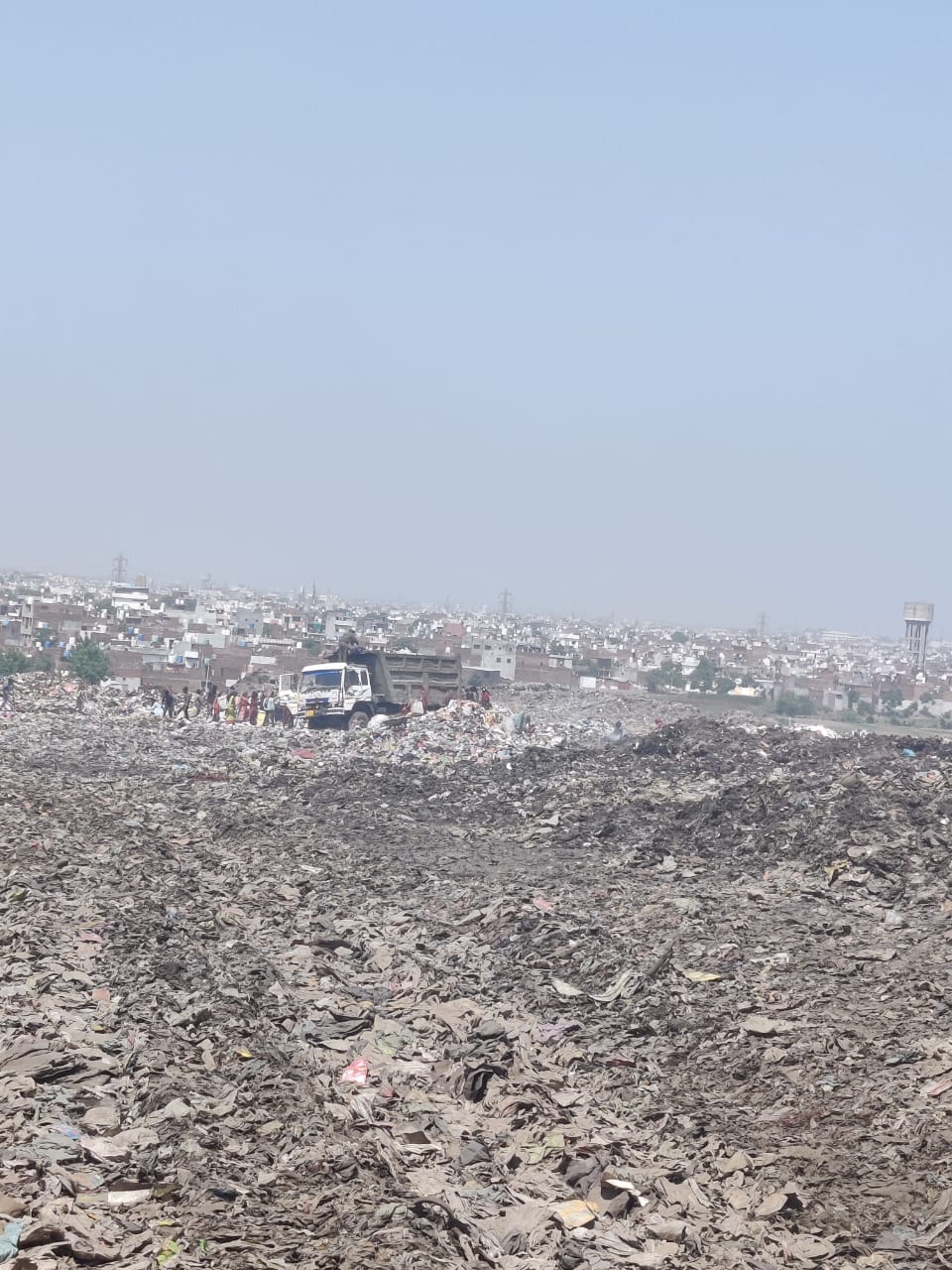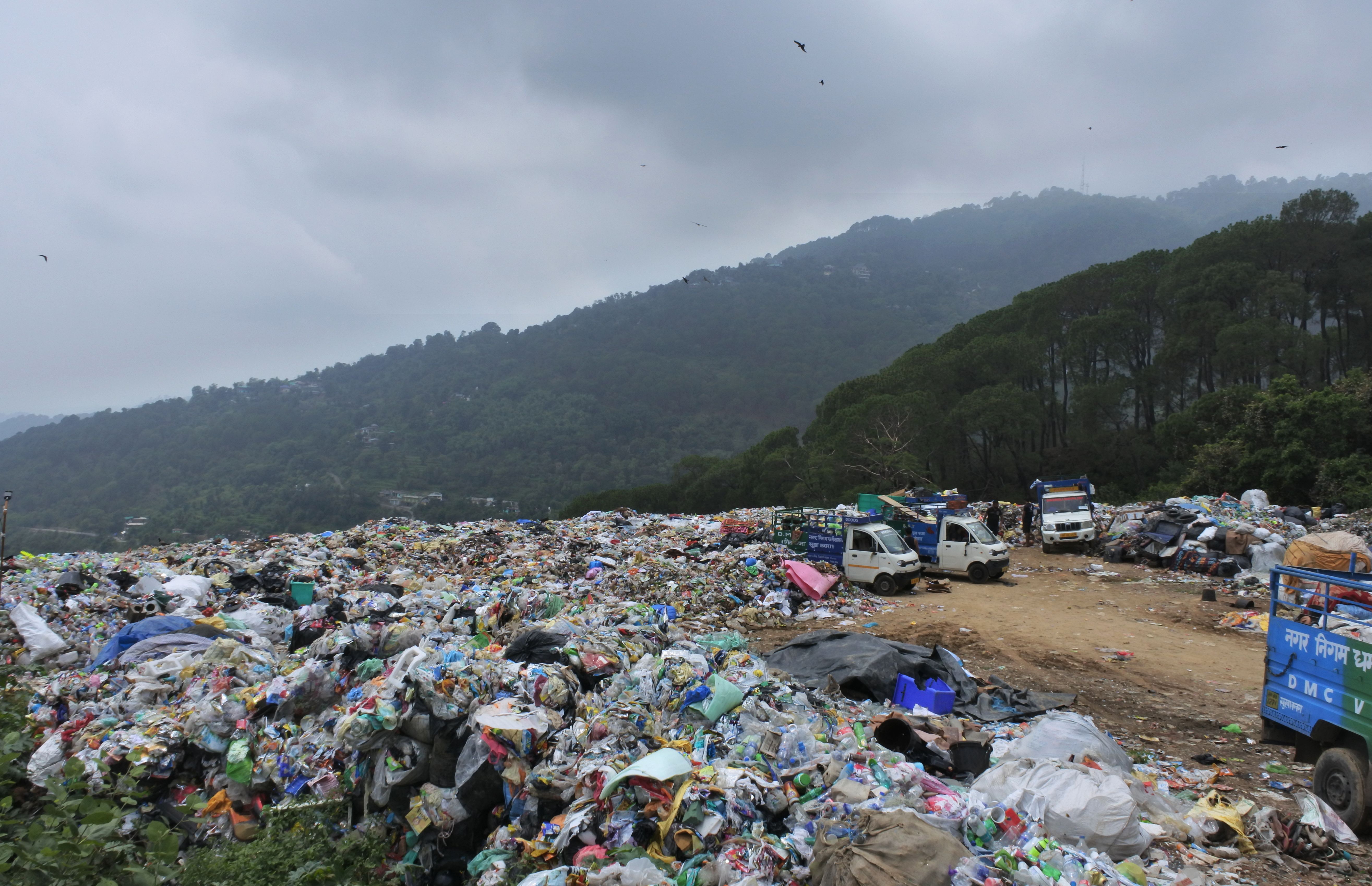
The villages with landfill sites in the vicinity of the Smart Cities suffer because of the lack of proper waste management plan. The beleaguered villagers have been fighting for their right to healthy living moving from one court to another, but without any success, writes Aayush Goel
Swanky malls, tall high rises, over 250 of global 500 fortune companies and everything that makes them cosmopolitan. The twin cities of Gurugram and Faridabad are Haryana’s window to the World. While Faridabad was selected amongst 100 smart cities in 2015, Gurugram which is proudly flaunted as Singapore of Haryana too is being developed as a smart city.
While one is left mesmerised and in awe of the progress made so far, but a drive down of around 15 km from these cities brings to fore the ugly facet of this development. Spread over 30 acres and standing 40 metre tall is the infamous Bandhwari waste mountain. In the absence of a proper treatment plan, it grows by almost 2000 metric tonnes every day pushing around 10000 odd residents of the area over the age with contaminated soil, water and air.
Bandhwari is not the lone case but the plight is shared by Sudher in Himachal Pradesh’s Dharamshala and Tajpur in Punjab’s Ludhiana. All these villages live in the shadow of so called smart and developed cities and have borne the brunt of their transformation. While the residents have since a decade now fought for their right to healthy living and moving from one court to another, the governments and authorities are yet to spare a thought regarding the same.
Bandhwari, Haryana
Bandhwari is a village that lies on Gurugram-Faridabad road. It along with neighbouring villages has around 5000 inhabitants. Landfill started in an abandoned mining pit and was welcomed as it brought profits for villagers who deployed their trucks here. Otherwise a flourishing village with duplex houses and a cricket academy, Bandhwari is dubbed as the bachelor’s village as majority of men are still single, all thanks to the garbage mountain and resultant health issues. This village along with neighbouring Mangar, Mandi, Baliwas and Gwal Pahari are the new cancer hubs of the region. The villages have reported over 40 cancer deaths since 2017.
“We curse the day when we allowed them to make landfill here. It killed everything in our soil, water and air. We had never heard of a disease in our area but today we have TB, gastro ailments, cancer and ophthalmic issues even in children. We have set up a water filtration plant in our village but of no use. Nobody wants to marry off their daughters to the boys of this village. We have set up our own water filtration plant and every house uses bottled water,” says village Sarpanch Raja Ram. A doctor in the local Ayushman Bharat health centre on condition of anonymity revealed that there had been a constant increase in gastro, dermatological and ophthalmic issues and patients were being referred to bigger hospitals.

A report by the Central Pollution Control Board in 2017 had revealed that groundwater of three villages around the landfill site was contaminated. Two years later in 2019, a report by the National Environmental Engineering Research Institute warned of the contamination even in neighbouring villages. Ever since, regular testing of ground water and soil has confirmed high toxicity. Environmentalists like Vaishali Rana Chandra have been fighting against the leachate being discharged from the landfill site into the Aravalis for the past several years, harming the wildlife and contaminating the groundwater.
“We have been fighting since 2017. The place was for solid waste but over 70 percent of the waste coming to this landfill is wet and leachate is seeping. We have been fighting for it in NGT and the Tribunal has issued many orders and directives but there is hardly any compliance. Even multiple visits by CM ML Khattar has failed to change things,” says Chandra.
The site and treatment is managed by contractor company EcoGreen and Municipal Corporation. The NGT had recently set July 2022 as the deadline to clear all legacy waste but they have already missed the deadline. Gurugram Deputy Commissioner Nishant Yadav has directed MCG officials and its solid waste management concessionaire Eco Green to expedite processing of legacy waste and the new deadline now is December 2023. The MCG on its part tried to resolve the issue by shifting landfill site but the locals of proposed sites have objected and are protesting.
MCG chief engineer Thakur Lal Sharma said the corporation had attempted to resolve the problem by identifying an alternative landfill site first in Farrukhnagar and then in Mohabbatabad, but they couldn’t be finalised due to objections from locals. Similar issues have now started to emerge in Karnal, second smart city of Haryana, where locals living in vicinity of solid waste management plant in Shekhpura, Suhana village on Meerut road are facing health crises. Karnal city (constituency of Haryana CM) generates around 200 tonne garbage per day, while the capacity of the plant is around 150 tonne. However determined not to go the Bandhwari way, Karnal Municipal Corporation has already expedited the processing and clearing of legacy waste.
Tajpur, Ludhiana
Ludhiana, the only city from Punjab that had made it to the first list of 100 “Smart Cities” way back in 2015, is an epitome of solid waste management crisis. With a defunct processing unit and legacy waste of over 21 lakh metric tonnes, city’s landfill on Tajpur road pushed over two lakh residents in the vicinity to a virtual hell. Not just water or soil contamination but regular fire at site leaves entire area choked for a major part of month. While the residents suffer, the civic authorities continue to be mute spectators. The residents of nearby Kakka village are the worst hit. Gurwinder Singh, sarpanch of Kakka village, said that the waste is never processed and the mountain is increasing each day. “Fires are common in the dump. You can buy bottled water but what about the air? Fires here are never extinguished completely and smoke continues to rise and the entire village is a pulmonary patient now,” he says. It may be noted that NGT had fined Ludhiana Municipal Corporation around 100 crores after seven were charred to death in this dump yard fire in 2021. The fine is yet to be fully paid.
Not just villagers but a public interest litigation was also filed by inmates of the central jail, which is nearby, regarding hepatitis B and other health issues due to contaminated water and air.
“We feel that this contaminated groundwater, which contains heavy metals and other harmful chemicals, is still being pumped out for prisoners. This is a violation of their fundamental rights,” stated the petition. According to amicus curiae in the case, HC Arora, the petition was clubbed with the ongoing case pending in NGT.

It may be noted that the industrial hub of Ludhiana produces around 11,00,000 kg, or 1,100 tonnes waste per day (TPD). The waste is dumped at its Jamalpur landfill site on Tajpur road and spread across 50 acres. The processing plant at the landfill site is non-operational after the private company which the MC had entered into an agreement with – for lifting and processing of solid waste – left work midway and the contract was terminated.
While the MC and the company are now locked in an arbitration battle and the blame game is on, the residents and environment are taking a hit. “The villagers have respiratory issues and communicable diseases owing to the large number of flies and mosquitoes. We are flooded with dermatological infections and cases of diarrhoea. The best advice we can give to them is not to drink supply water and use bottled water,” says Dr. Gurmukh Singh who runs a hospital in Tajpur area.
It was in May this year that taking cognizance of the fact that garbage dumping site pollutes groundwater, a National Green Tribunal (NGT) panel had directed authorities that all the water pumps in the ambit of 2 km from the dumping site be seized and required alternative arrangement be made to ensure safe drinking water supply to the residents. “There are many problematic aspects to the garbage dump. One, because of the smoke, people, especially elderly and children, suffer respiratory issues. It is a health hazard for pregnant women. Second, during the rainy season, water from garbage seeps into the groundwater and contaminates it. The MC is solely responsible for not taking appropriate remedies,” said local environmentalist Kapil Arora.
Similarly in Jalandhar, also enlisted as a smart city, the solid waste treatment is a non-starter as village Wariana deals with a dump of 8 lakh metric tonnes. In 2017, a bio-mining project was planned to manage and process the waste at Wariana dump however nothing concrete has happened so far. The overflowing waste is spewing toxins into the air leaving people ill in nearby areas. The civic authorities are holding the concessionaire company responsible and according to Krishan Sharma, assistant health officer, MC has been imposed a penalty on company.
Like its two other counterparts, Amritsar’s Bhagtanwala dump too faces similar issue. The residents of the area are harried over constant fire in dump which has made the air extremely unhealthy. The dump piled up near the grain market occasionally catches fire as well and remain up in flames for days. Area residents claimed that the Municipal Corporation employees don’t even visit the dump to douse the flames. The leachate from dump hill flows to the Upper Bari Doab Canal which is key water source for over 20 villages. “The landfill has polluted air, water and soil and spread diseases in entire area. The Bhagtanwala dump is a perennial political issue but the successive governments have failed to deal with it. The residents are losing all hope now”, said Kulwant Singh Ankhi, patron of Amritsar Vikas Manch.
Summing up the waste management woes of Punjab the NGT monitoring panel head Justice (retd.) Jasbir Singh says environment is sadly the last priority in state while it should be first. “In rush of advancement, we are moving ahead in an unplanned manner. We are putting natural resources, health and even the lives of people at stake for the development of one area. There are clear guidelines and directives for issues like waste management but there is no execution. Either move the landfill or the people as their health is facing a grave risk. Arrangements need to be made for immediate provision of clean potable water. While some work has been initiated at Amritsar site, Ludhiana and Jalandhar are yet to wake up to the crisis”, he said while talking to Tehelka.
Sudher, Himachal Pradesh
Dharamshala and its twin town of McleodGanj are stars on world tourism and spiritual map for being the abode of Dalai Lama. Not just this, Dharamshala is also a proud member of 2015 list of 100 smart cities.
While everything looks pristine here at first sight, one has to drive down a few kms to witness the price of this development. Sudher, just another off road quaint village with a population of around 5000, has allegedly been facing unscientific dumping of non-segregated waste. This is generated by 53000 residents, hotels, homes, offices and even hospitals of Dharamshala and its suburb, McLeodganj since last decade. Taking a daily dump of 30 tons, the dumpyard has become an inseparable part of village’s landscape. It has polluted the air, water and soil of village overturning their lives forever.
The village became home to dermatological and ophthalmic ailments owing to contamination of their sole water source the Kuhl or water community channel now called ‘Khooni Nala’. “This is our Kuhl. It was always crystal clear but turned yellow in the last six years and gets crimson even. We now call it Bloody river. This flow down brings leachate and kills our crops, animals and even our elders and children. This has killed our indigenous profession and now our men have gone to work in shops and hotels. We face regular disease outbreaks and the majority of villagers have constant skin issues. As it affected every single house in the village we women had a common pain, which brought us together. It sounds funny but once every month we come here and pledge that we will get the waters back to pristine and leave our children a crystal clear stream reflecting the struggle of their moms,” says Sunita Thakur. Thakur, president of local Bageshwari Mahila Mandal, along with 48 women of the village has been fighting for six years to get the dumpyard shifted and save the village. They have pooled in their resources to stage dharnas, file RTIs and even move the NGT. As per the petition made by a group in NGT in 2019, the dump yard violates the Solid Waste Management Rules, 2016 and threatens their lives and livelihoods. In March, 2019, the NGT disposed of the case asking the Municipal Corporation to adopt a cluster approach but nothing has been done so far.
Commissioner of Dharmashala Municipal Corporation Pradeep Thakur while speaking to Tehelka said that they were privy to the woes and were working to resolve the issue. “We have got funds of around Rs 1 crore and legacy waste will be removed. We are setting up a plastic treatment plant. The non-segregation of waste is the biggest hurdle,” he said.













